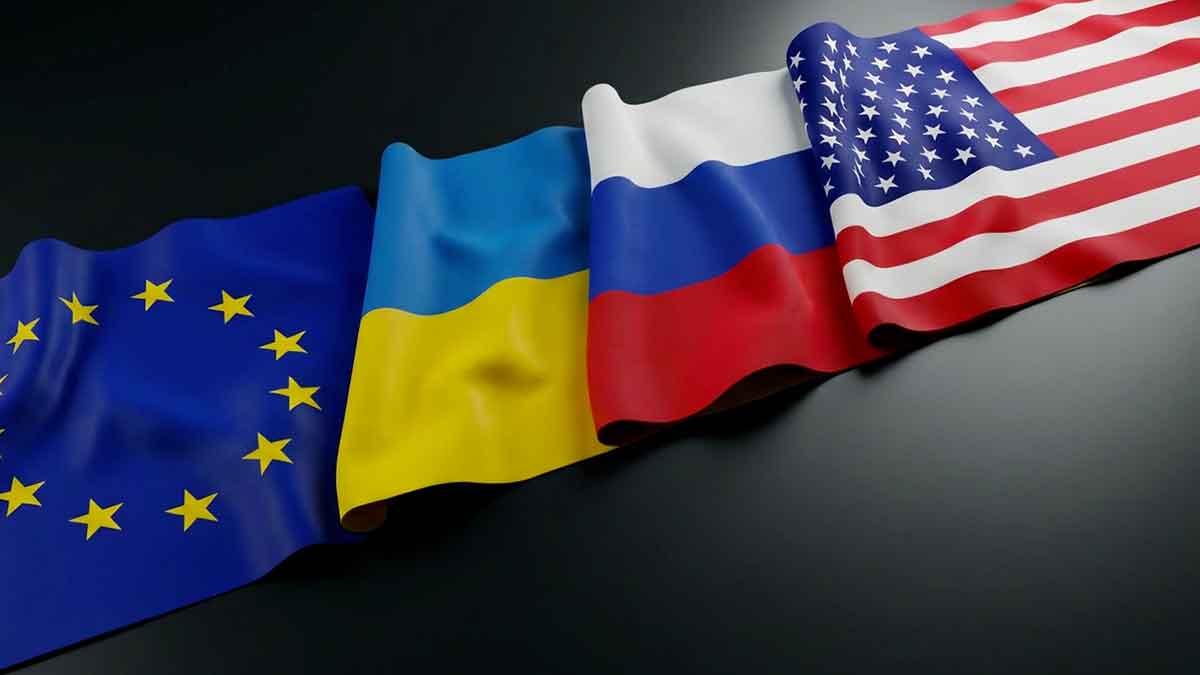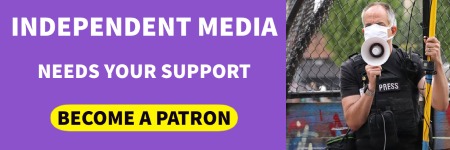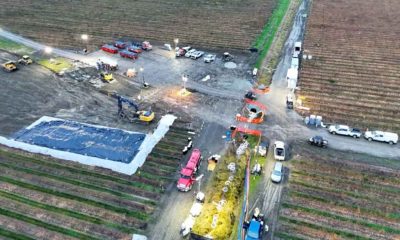International News
Washington and Kyiv Say Trump Peace Plan Negotiations ‘Highly Productive’
Some diplomatic tensions ease after Ukraine and U.S. release joint statement underscoring “meaningful progress” in ongoing talks.

The United States and Ukraine released a joint statement on Sunday declaring that discussions on a peace proposal to end the almost 12-year-long Russia-Ukraine War were “highly productive.”
“The talks were constructive, focused, and respectful, underscoring the shared commitment to achieving a just and lasting peace,” diplomats from both countries said in a statement. “Both sides agreed the consultations were highly productive…They reaffirmed that any future agreement must fully uphold Ukraine’s sovereignty and deliver a sustainable and just peace.”
Speaking to reporters after today’s talks concluded, U.S. Secretary of State Marco Rubio said, “It is in my personal view that we’ve had probably the most productive and meaningful meeting so far in this entire process since we’ve been involved in it from the beginning.”
U.S. Special Envoy to Ukraine, Keith Kellogg, told Fox News, “Trump’s brought it [Russia-Ukraine War – Ed.] to a place where the last ten meters are the hardest. We’re in about the last two meters.”
Negotiators from Ukraine, the U.S., and the European Union created a new draft and “refined peace framework.” The language softened from Friday, when the 28-point Witkoff-Dmitriev Peace Plan was presented to Kyiv as a “take it or leave it” demand, with mandatory acceptance by November 27.
“The Ukrainian delegation reaffirmed its gratitude for the steadfast commitment of the United States and, personally, President Donald J. Trump for their tireless efforts aimed at ending the war and the loss of life,” the statement from the White House said.
It was released within minutes of President Trump posting on his personal social media network, Truth Social. “I INHERITED A WAR THAT SHOULD HAVE NEVER HAPPENED,” Trump wrote in all caps. “A WAR THAT IS A LOSER FOR EVERYONE, ESPECIALLY THE MILLIONS OF PEOPLE THAT [sic] HAVE SO NEEDLESSLY DIED. UKRAINE [sic] LEADERSHIP’ HAS EXPRESSED ZERO GRATITUDE FOR OUR EFFORTS, AND EUROPE CONTINUES TO BUY OIL FROM RUSSIA.”
On October 23, Trump posted on Truth Social that the Ukrainian Armed Forces can “win all of Ukraine back in its original form,” as long as it received continued support from the European Union and NATO.
The British news outlet The Telegraph published what it claimed was a 24-point U.S.-Ukraine framework, which Russia’s chief negotiator and manager of the National Welfare Fund, Kirill Dmitriev, dismissed. “EU warmongers want to continue till the last Ukrainian,” Dmitriev posted on Twitter (X).
Rubio and the Chief of Staff of the Office of the President of Ukraine, Andriy Yermak, said that Ukrainian President Volodymyr Zelenskyy and President Trump will make the final decision on the peace framework.
No One Wants to Take Ownership of the Original Plan
Adding to the confusion on the origin and validity of the original Dmitriev-Witkoff plan, by Saturday, no one appeared to want to take ownership of the document.
On Friday, the New York Post reported that an unnamed White House official said that National Security and Defense Council Secretary Rustem Umerov worked with Washington on the plan. “So Umerov agreed to the majority of this plan, and he made several modifications to it, which we included and presented it to President Zelenskyy.”
Through a written statement, Umerov denied the report. “This is not within my authority and does not correspond to the procedure…Publications in the media about alleged ‘agreements’ or ‘removal of points’ have nothing to do with reality.”
Dmitriev, supported by Ravid, insisted it came from the U.S. and was authored by Rubio and Witkoff. Rubio briefed several Senators, including Angus King (I-ME), Mike Rounds (R-SD), and Jeanne Shaheen (D-NH), and, in a public statement, Rounds claimed that Rubio called the document Moscow’s “wish list” and not the work of the U.S.
A spokesperson for the State Department called the claim “patently false. “Rubio followed up on social media, posting, “The peace proposal was authored by the U.S. It is offered as strong framework for ongoing negotiations. It is base on input from the Russia side. But it is also based on previous and ongoing input from Ukraine.”
King fired back on Sunday. “First, it is troubling the plan appears to have been developed after extensive consultation with the Russians and little, if any, input from Ukraine or our European allies,” King said.
He added that there are “many problems with the plan,” with the most obvious issues being “it rewards Russia’s illegal and unprovoked aggression by handing over substantial portions of Ukraine’s sovereign territory, and its security guarantees against further Russian aggression are vague and inadequate.”
Polish President Donald Tusk, considered a close ally of Trump, also expressed frustration. “Together with the leaders of Europe, Canada, and Japan, we have declared our readiness to work on the 28-point plan despite some reservations. However, before we start our work, it would be good to know for sure who is the author of the plan, and where was it created.”
German Chancellor Friedrich Merz was more direct, telling German news outlet Deutsche Welle (DW) that Europe was not facing a “deep threat” to its existing security architecture.
“I had a call with President Trump,” Merz said. “I told him that we could agree on some of them, but there are others we could not agree. And I told him that we are fully in line with Ukraine, that the sovereignty of this country must not be jeopardized.”
Hungary’s Prime Minister, Viktor Orbán, put his fully support behind the plan, adding he had notified the European Commission that unless Brussels “immediately and unconditionally” supports the outline, he will block all forms of European aid to Ukraine.
Europe has seen a dramatic increase in hybrid warfare attacks connected to Russia, including multiple airspace violations by Russian drones, missiles, and aircraft in Estonia, Latvia, Lithuania, Poland, Moldova, and Romania.
On Saturday, Russian drones struck the Orlivka-Isaccea Border Crossing between Romania and Ukraine, forcing its closure due to damage. Two Ukrainian civilians were injured in the attack, and Romania issued a “Ro Alert,” their equivalent of an air raid warning, and scrambled two pairs of F-16s during the attack.
Russia has also been accused by Belgium and Denmark of drone flights over sensitive civilian and military locations, and on Saturday night, Dutch air defenses tried to shoot down drones flying over Volkel Air Force Base, which is a U.S. nuclear weapons storage site.
On November 15, divers in the U.K. found a Russian sonobuoy near Wooltack Point on Skomer Island. British officials believe the tracking buoy was deployed by the Russian spyship Yantar, which has had several confrontations with the Royal Navy since November 2024. The most serious incident was on November 19, when the Yantar reportedly used lasers to target several Royal Air Force aircraft, including a P-8 Poseidon maritime surveillance aircraft and at least two Eurofighter Typhoons. Moscow denied the incident, while London threatened direct military action if provocations continued to escalate.
Ukraine Can’t Deliver Many Parts of the Dmitriev-Witkoff Plan
Several sections of the peace framework can’t be delivered by Ukraine and would require broad multinational agreements from other parties that could take months or years.
The document calls on NATO to commit not to expand further, thereby putting a limit on any further additions. Currently, Bosnia and Herzegovina has been invited to participate in a Membership Action Plan, which is the first serious step toward NATO membership.
The plan also called for Poland to host all European NATO forces deployed as a “trigger” force, without consulting Warsaw on the plan’s viability. Russia is to be reinvited to the G8, an organization Ukraine isn’t a member of. It outlines a requirement for the World Bank to provide a reconstruction loan to Ukraine, and to transfer $100 billion in frozen Russian assets to the U.S. Currently, an estimated $5.4 billion of the $300 billion in Russian assets is held in the U.S., with approximately $180 billion under management by Belgian financial institutions.
An unnamed E.U. official in Brussels was blunt in dismissing the banking transfer of Russian funds, saying, “Witkoff needs to see a psychiatrist.”
Moscow has also signaled it has no interest in signing any deal with Washington or Kyiv. Autocrat Vladimir Putin believes that he can outright win the ongoing war of aggression, and has never negotiated in good faith. In 2011, Putin expressed his long-term plan to be remembered as a tsar by restoring the pre-World War I borders of the Russian Imperial Empire. He then wrote the same intentions into a manifesto, which all Russian soldiers are required to read and can be downloaded as a digital book from the Russian Ministry of Defense website.
Axios Reporter Who Broke the Story Comes Under Fire
Barak Ravid, the Global Affairs Correspondent for Axios and a former high-ranking Israeli intelligence officer, came under fire on Saturday, accused of unintentionally amplifying a Russian information operation.
Ravid was the first to report on the framework, which blindsided political leaders around the world, including in Brussels, Washington, Kyiv, and Moscow. On Wednesday, U.S. Special Envoy to the Middle East and Russia, Steve Witkoff, appeared to have accidentally replied publicly to a tweet by Ravid, which was deleted almost immediately.
“Scoop: U.S. secretly drafting new plan to end Ukraine War,” Ravid posted, followed by Witkoff replying, “He must have got this from K.”
K was believed to be Kirill Dmitriev, who, on Saturday, in a tweet defending Ravid, confirmed that he had provided the document. Ravid came under fire from his peers, accused of spreading a Russian information operation and not doing enough due diligence in his report. He responded on Saturday night by blocking a number of his detractors on social media.
Ravid claimed in his story that Dmitriev and Witkoff, with the help of Donald Trump’s son-in-law Jared Kushner, ironed out the 28-point plan during a three-day session at a Miami hotel. Dmitriev’s trip to Miami on October 25 was public knowledge, but he stayed for less than 2 days and posted on social media upon his departure.
The official version of the Dmitriev-Witkoff 28-point peace plan, published on Friday, used language, spelling, and grammar typical of the Russian Foreign Ministry and did not align with a document prepared by a native English speaker.
Both Combatants Need a Durable Ceasefire
Russia and Ukraine both need a durable ceasefire for differing reasons.
Ukraine has been purely on the defensive since December 2024, and while Russian gains have been measured in meters and no operational goals have been achieved in 2025, the advances have been relentless. Russian troops are on track to capture an area roughly the size of Rhode Island by the end of the year.
Kyiv has been rocked by a $100 million embezzlement scandal involving energy companies Ukrenergo and Energoatom. Seven people have been indicted, with a Zelenskyy insider, Tymur Mindich, fleeing to Israel hours before he was to be taken into custody. Russian-aligned voices point to the criminal investigation as proof of Ukraine’s corruption, while supporters point out that if anti-corruption organizations weren’t working, the embezzlement wouldn’t have been uncovered.
Ukraine is also facing a shortage of military personnel, largely due to systemic problems within the Territorial Centers of Recruitment (TCCs). In August 2022, Zelenskyy purged the leadership at all 39 TCC groups due to rampant corruption, which hobbled mobilization. While issues such as institutional corruption, pay, and insufficient military training have been significantly improved in 2025, the TCC leadership structure still hasn’t recovered.
The Russian maintained UALosses website lists 84,475 Ukrainians killed in action since February 2022, with an average age of 38.5. Contrary to Russian propaganda claims that Ukraine’s demographics have been hollowed out, approximately 210 Ukrainian soldiers, 60 or older, have been killed in action, and less than 500 aged 18 to 19.
While Russia is finding success on the battlefield, since January, most of its gains have been in empty fields, forested belts, and small villages. None of Moscow’s operational goals to capture Kupiansk, Lyman, Siversk, Chasiv Yar, Kostiantynivka, Myrnohrad, Pokrovsk, Novopavlivka, Huliaipole, and Orikhiv have been met.
Russia falsely claimed the capture of Chasiv Yar in July and Kupiansk in November. Ukraine still controls approximately 10% of Chasiv Yar and has been conducting a localized offensive in Kupiansk with some success since mid-October.
Moscow has resorted to false claims and picture reports in some areas to hide its lack of progress. This has been a common problem since 2022, and in October 2024, two Russian generals were relieved of command for releasing picture reports, the act of sending a small squad of troops to wave a flag in an area they don’t control, near Siversk in the Donetsk Oblast. For every square kilometer captured this year, Russia has lost approximately 87 soldiers, killed, wounded, captured, or missing.
Most analysts agree that it will take Russia 18 to 48 months to capture the rest of the Donetsk and Luhansk oblasts, while suffering up to 2 million more losses.
The Russian government is also facing a financial crisis. The Central Bank has printed over 6 trillion rubles in currency to sell through OFZ bonds and repo transactions with large banks. As of August, 70% of Russians reported they had no personal savings, and the savings rate fell to an 8-year low. Urals crude oil hit $36.61 a barrel earlier this month, against a Ministry of Finance revenue target of $70. Inflation remains far above the target rate of 4%, with an official rate of 8.1% and the key lending rate at 16.5%. The servicing cost of the national debt is expected to rise to 30% of the federal budget due to high yields.
Moscow plans to cut its military budget in the upcoming year and is poised to slash investment in drone, aircraft, and missile technology, while increasing taxes, including a 2% jump in VAT, which is currently at 20%. Several regions, which are partially responsible for paying and equipping Russian troops, have suspended promised signing bonuses and paying survivor benefits to families due to a lack of funds.
Public court records from both combatants show that both are facing an increasing number of soldiers going absent without leave and deserting.
Journalism in the United States is under attack. Malcontent News is an independent news agency established in 2016 and a Google News affiliate. To remain independent, we rely on our subscribers to help us limit advertising. The easiest way to support our team is to subscribe to our Substack, Patreon, or Newsbreak.










